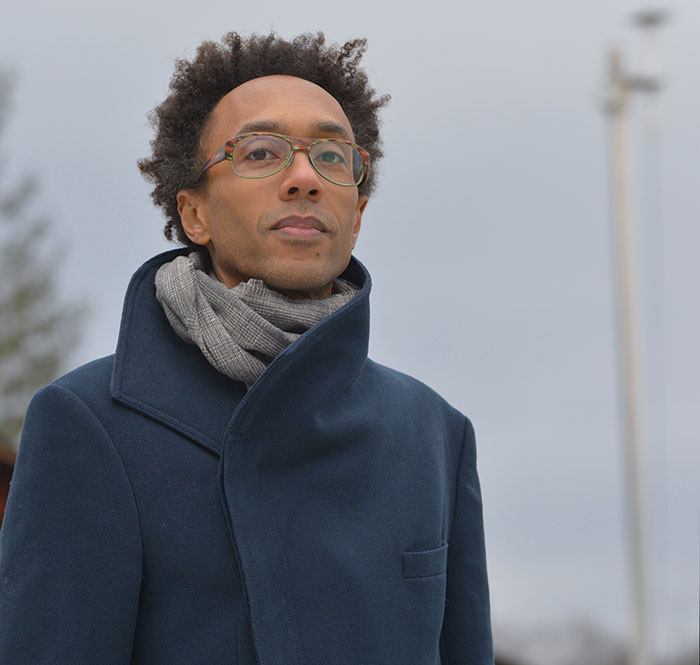
Photo: Rob Long / Clear Story
Jace Clayton only wears headphones on airplanes. As an ethnomusicologist and DJ—the latter of which conjures an image of noise-cancellers slung permanently over the ears—music for him is a result of being alive to the world rather than escaping from it. As a kid, Clayton often rode the Boston-Cambridge metro system into the city to search for records. The sound of an arriving train shrieking along the tracks remains one of his favorites, a mechanical but distinctly musical entrance. Each space has its own sonic landscape, says Clayton, which provides unique links to place. It’s an idea he explores in his new book Uproot: Travels in 21st-Century Music and Digital Culture. After releasing his live-recorded mixtape Gold Teeth Thief in 2001, Clayton became a dance-hall darling, invited to travel the world to make music. As DJ /rupture, he mixes everything from Latin American cumbia to traditional Berber music, conducting it all through a digital interface as well as his own broad view of the world. The New York-based artist believes the early 21st century will be remembered as a time of forgetting—when how and what we shared became increasingly digital and transient. Yet, it’s also the age of the Anthropocene, when humans’ impact on the planet is so great it will be logged in the geologic record. As part of the Carnegie Nexus art-science event series, Strange Times: Earth in the Age of the Human, Clayton composed a temporary sound installation for The Andy Warhol Museum’s popular Silver Clouds gallery. Inspired by the work of museum researchers at Powdermill Nature Reserve, the environmental research station of Carnegie Museum of Natural History, it explores the tussle between music and memory, analog and digital.
What were you drawn to at Powdermill Nature Reserve?
It’s rare for an artist to get to interact with someone doing hard science, but scientists are looking at the world with profound curiosity. One of the fascinating things scientists at Powdermill do is tag birds with tiny radio transmitters. Each bird is given a specific radio Morse code, and as they fly over various sensory antenna, the scientists capture these radio frequencies, tracking the bird’s migration. What’s captured is the sound of a bird, but that sound is made by humans. And it’s designed to be listened to by machines. I was drawn to these sounds because they reflect that sort of mixed up post-natural world of the Anthropocene that Strange Times is all about.
Silver Clouds is interactive. What is your goal for the work you’ve added to it?
I want to add my own layer of sound and meaning to the room, but I also want to go with the magical moments that are already being created by Silver Clouds. I often discuss music-making as extended conversation, thinking of sound as dialogue. Silver Clouds is the room in the museum where you’re encouraged to move around and physically interact with the artwork. It pulls out this childlike wonder. And it contains within itself the seeds of a choreography: People go in there and they want to loft the balloons in the air, they want to tap them so there’s spin. What I’ve created is similarly open-ended, not a song that starts and ends.
What do you want people to walk away with after listening to it?
A sense of wonder. Silver Clouds is this space where all sorts of people can feel equally comfortable within the museum. That sense of openness and play is something I want to express musically. To extend that spirit, this very generous, shiny, future optimism that we get from Silver Clouds.
Considering the theme of Strange Times, do you feel optimistic?
I do. Art offers the sense that there are always more possibilities, there are always new ways to think about what it means to bring people together in the room. It’s a reminder that there are many different ways of being in the world, of organizing ourselves and assigning value.
In Uproot, you write that the 21st century will be a time of forgetting. But isn’t it also a time of documenting? The internet doesn’t forget.
So much of what we think of as memory, that constitutes ourselves, that constitutes our cultures, is not capable of being digitized. You know, you can quote someone’s tweet, but do you know what that person’s laugh was like? Music is something that people hold so dear to them, and yet it can so easily be translated into just a bunch of zeroes and ones and made digital. It conjures up the specter of what is memory, what is it to record something?
As an artist, how do you deal with this transience?
I celebrate it. And this is actually one of the funny things about working so much as a DJ. It’s the opposite of classical music, where everyone’s fixed in a chair, looking the same direction, completely silent. When you’re DJing, there will be people talking over you, half the room doesn’t know who you are. A lot of my work is creating meaningful sonic space that doesn’t impose itself with any one meaning or any one way people should interact with it.
Receive more stories in your email
Sign up